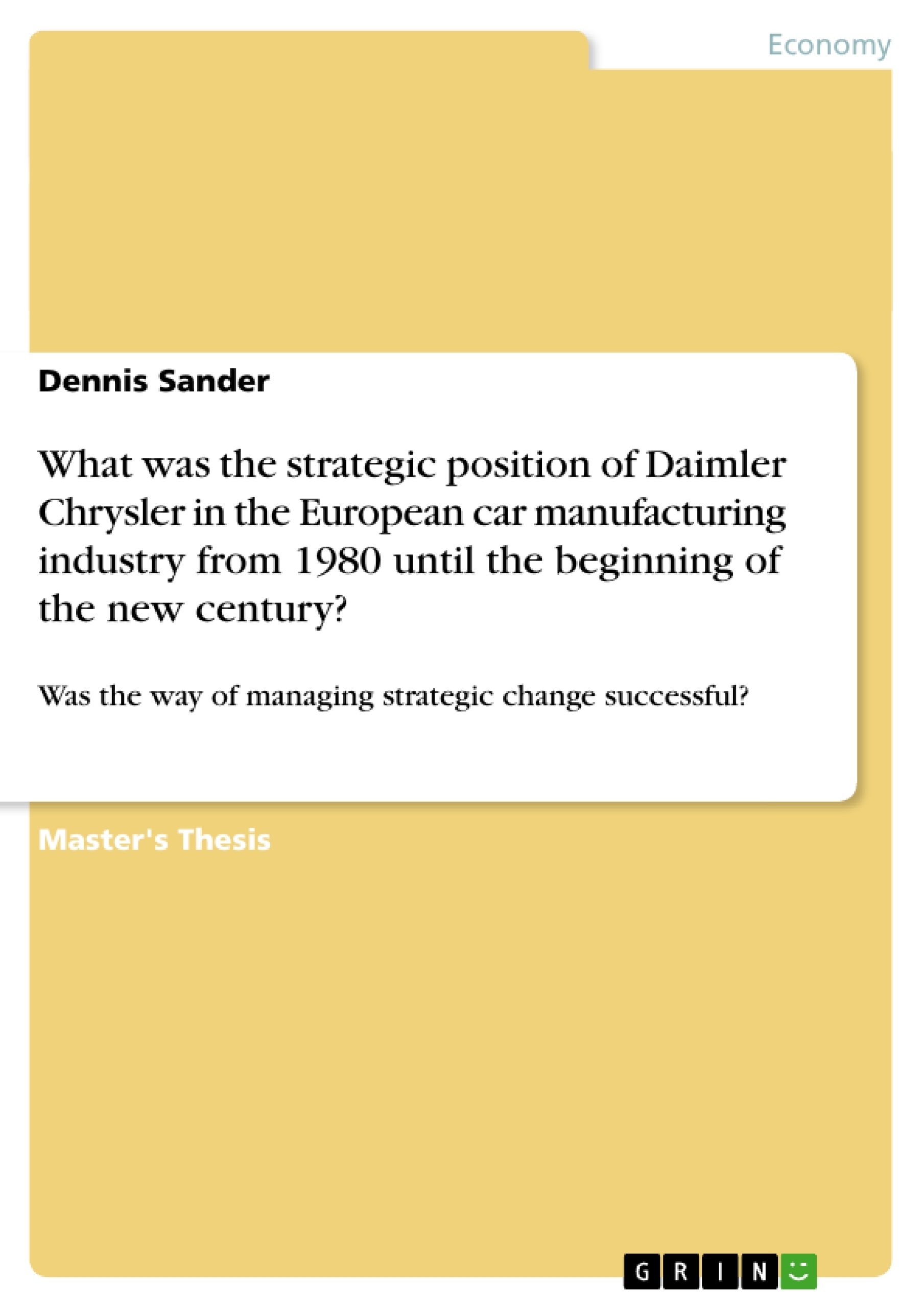This dissertation is about strategic positioning and managing strategic change. The first
chapter makes clear the importance of clear defined strategy, mergers & acquisitions as
well as alliances resulting out of increasing globalisation and gives Daimler Chrysler as a
good example for analysing these managerial issues.
Chapter two shows different strategies Daimler Chrysler was/ is following, a diversified
one in the 80’s and a focused-orientated strategy in the 90’s. Increasing threats of saturated
markets, global competition, fluctuating economic influences and rising technological
standards had/ have to be coped with by Daimler Chrysler in using their strengths of wellknown
brand reputation, high quality standards and developed service culture. The result
was a strategic position emphasising the upper car segment in the 80’s as well as reliable
commercial vehicle and a completer range of products in the 90’s trying to serve nearly all
segments in the car market.
Chapter three deals with the management of strategic change and the process of becoming
a global player in the car manufacturing industry. Problems a merger causes concerning
differences in culture and management are considered and the act that concentration of
power (as it happened at Daimler Chrysler at the time while the merger took place) on
charismatic top management obviously paid off in the late 90’s.
The final chapter four demonstrates the difficulty of fostering successful change
management and the necessity of mergers and alliances when following a global concentric
growth strategy. It becomes obvious that, although the automobile industry is confronted
with severe competition, Daimler Chrysler has the potential of getting the major player in
this industry. When following consequently the chosen path of focussing on the car
manufacturing sector and implementing new technologies and customer demands fast
(faster than potential competitors), then Daimler Chrysler will be at the “top of the league”
in the future.
Inhaltsverzeichnis (Table of Contents)
- ACKNOWLEDGEMENTS
- STRUCTURE
- LIST OF ILLUSTRATIONS (WITHOUT APPENDIX)
- ABSTRACT
- CHAPTER 1
- 1. INTRODUCTION
- 1.1. OBJECTIVES OF THE DISSERTATION
- 1.2. CHOOSING THE ANALYTICAL TOOLS
- 1.3. AREAS OF RESEARCH AND DATA COLLECTION
- 1.4. DEVELOPMENT OF THE EUROPEAN CAR MANUFACTURING INDUSTRY
- 1.5. READER'S MAP
- CHAPTER 2
- 2. EVALUATING THE STRATEGIC POSITION
- 2.1. ENVIRONMENTAL ANALYSIS
- 2.1.1. Macro Environment
- 2.1.1.1. Situation in the 80's
- 2.1.1.2. Situation in the 90's
- 2.1.2. Industries and sectors
- 2.1.2.1. Situation in the 80's
- 2.1.2.2. Situation in the 90's
- 2.1.3. Strategic groups (Porter, 1980)
- 2.1.3.1. Situation in the 80's
- 2.1.3.2. Situation in the 90's
- 2.1.4. The organisational field
- 2.1.4.1. Situation in the 80's
- 2.1.4.2. Situation in the 90's
- 2.1.5. Market Segments
- 2.1.5.1. Situation in the 80's
- 2.1.5.2. Situation in the 90's
- 2.1.6. Opportunities and threats as part of the SWOT analysis (Andrews, 1980)
- 2.1.6.1. (SW)OT-analysis for the 80's
- 2.1.6.2. (SW)OT analysis for the mid 90's
- 2.2. STRENGTHS AND WEAKNESSES AS PART OF THE SWOT ANALYSIS (ANDREWS, 1980)
- 2.2.1. SW(OT) analysis for the 80's
- 2.2.2. SW(OT) analysis for the 90's
- CHAPTER 3
- 3. MANAGING STRATEGIC CHANGE
- 3.1. ANALYSING STRATEGIC CHANGE
- 3.1.1. Types of strategic change
- 3.1.2. Strategic context
- 3.1.3. Organisational culture
- 3.1.4. Forcefield
- 3.2. MANAGEMENT STYLES AND ROLES
- 3.2.1. Management styles
- 3.2.2. Management roles
- 3.3. LEVERS FOR STRATEGIC CHANGE
- 3.3.1. Structure and Control Systems
- 3.3.2. Organisational routines
- 3.3.3. Symbolic processes
- 3.3.4. Political processes
- 3.3.5. Communication change
- CHAPTER 4
- 4. DISCUSSION AND CONCLUSION
- 4.1. IMPLICATIONS OF THE DAIMLER CHRYSLER CASE STUDY
- 4.2. PERSONAL OPINION ABOUT THE RESULTS OF THE CASE STUDY ANALYSIS
- 4.3. EXPLANATORY REMARK ABOUT THE CASE AND CHOSEN ANALYTICAL TOOLS
- 4.3. FUTURE OUTLOOK
- 4.3.1. The car manufacturing industry
- 4.3.2. Daimler Chrysler
- APPENDIX
Zielsetzung und Themenschwerpunkte (Objectives and Key Themes)
This dissertation aims to analyze the strategic position of Daimler Chrysler within the European car manufacturing industry from 1980 until the turn of the century. It further seeks to evaluate the success of the company's approach to managing strategic change during this period.
- Strategic position of Daimler Chrysler in the European car industry
- Environmental analysis of the car manufacturing industry
- Strengths and weaknesses of Daimler Chrysler
- Managing strategic change within Daimler Chrysler
- Implications and future outlook for Daimler Chrysler
Zusammenfassung der Kapitel (Chapter Summaries)
Chapter 1 introduces the dissertation's objectives, analytical tools, and research areas. It also provides a brief overview of the development of the European car manufacturing industry.
Chapter 2 examines the strategic position of Daimler Chrysler through an environmental analysis. This includes analyzing the macro environment, industry and sector trends, strategic groups, the organizational field, and market segments. The chapter also assesses opportunities and threats using SWOT analysis.
Chapter 3 delves into the management of strategic change at Daimler Chrysler. It analyzes the types of strategic change, the strategic context, organizational culture, and forcefield analysis. The chapter also examines management styles, roles, and various levers for managing change, such as structural changes, organizational routines, symbolic processes, political processes, and communication change.
Schlüsselwörter (Keywords)
This dissertation focuses on strategic management, the European car manufacturing industry, Daimler Chrysler, strategic change, environmental analysis, SWOT analysis, organizational culture, management styles, and levers for strategic change.
- Quote paper
- Dennis Sander (Author), 2003, What was the strategic position of Daimler Chrysler in the European car manufacturing industry from 1980 until the beginning of the new century?, Munich, GRIN Verlag, https://www.grin.com/document/29894



